Calculating carbon savings from wind farms on Scottish peat lands: a new approach
This approach was developed to calculate the impact of wind farm developments on the soil carbon stocks held in peats. It provides a transparent and easy to follow method for estimating the impacts of wind farms on the carbon dynamics of peat lands.
Appendix 2: Calculating Potential Carbon Losses & Savings from Wind Farms on Scottish Peat lands: a total life cycle perspective
Wind Farms and Carbon Savings on Peat lands
This paper presents a method to calculate carbon emission savings associated with wind farm developments on Scottish peat lands using a full life cycle analysis approach. This can be used to look at the wider emissions and savings of carbon associated with windfarms if required in comparison to other energy sectors. It is supplemented by an EXCEL spreadsheet (Nayak et al., 2008) containing the calculations. It is assumed that good management practice is followed, as outlined by the Scottish Executive (2006), to avoid catastrophic losses of carbon, such as by peat landslides. The full carbon calculator can be obtained from the following hyperlink: http://www.scotland.gov.uk/WindFarmsAndCarbon.
Summary
Large scale wind farm development proposals in Scotland have raised concerns about the reliability of methods used to calculate the carbon savings associated with wind farms, as compared to power derived from fossil-fuel and other more conventional sources of power generation. This is largely due to the siting of wind farms on peat lands which represent large stores of terrestrial carbon. Government policy is to deliver renewable energy without environmental harm and to deliver biodiversity objectives, including the conservation of designated wildlife sites and important habitats such as peat lands. The implications for carbon emissions of developing a wind farm are therefore just one set of factors that should be included in the consideration of future change. This note provides a revised methodology to explore potential carbon emission savings and losses associated with a wind farm development in forestry or on peat land. The total carbon emission savings from a wind farm are estimated with respect to emissions from different power generating sources, loss of carbon due to production, transportation, erection, operation and dismantling of the wind farm, loss of carbon from backup power generation, loss of carbon-fixing potential of peat land, loss of carbon stored in peat land, carbon saving due to improvement of habitat and loss of carbon-fixing potential as a result of forestry clearance.
A2.1. Introduction
The 2007 renewable energy policy of the Scottish Government ( SG) has a target of 50% of electricity generated in Scotland to come from renewable sources by 2020, with an interim target of 31% by 2011 (Scottish Government, 2008).
Scottish Natural Heritage ( SNH) stresses the value of renewable sources of electricity generation in tackling climate change and provides advice on the siting of renewable energy installations to ensure that the technology is best matched to the potential offered by a location to minimise adverse impacts on the natural heritage ( SNH, 2007, pages 23, 36).
The presence of extensive areas of forestry on and in the vicinity of the wind farm site can significantly reduce the yield of wind energy, so it has often been the practice to clear existing forestry from the area surrounding the site prior to wind farm development. The cleared land has then often been left as open ground. However, to reduce the long term loss of woodland alternative approaches should always be considered - such as 'key-holing' combined with replacing felled trees with short rotation coppice/ short rotation forestry or low-height native woodland. SNH published a Technical Guidance Note in 2003 for calculating carbon 'payback' times for wind farms. The 2003 guidance adopted a relatively simple approach towards impacts on peat land hydrology and stability. This method presented here is a more comprehensive approach towards these issues.
A2.2. Background
Organic soils are abundant in Scotland, containing 2735 Mt carbon. Scotland contains 48% of the soil carbon stocks of the UK (Bradley et al., 2005). Depending on land management, organic soils can either act as carbon sinks or as carbon sources. Soils in Scotland act as a carbon sink, absorbing 1.26 Mt CO 2-C more carbon dioxide than they release due to the impacts of changes in land use, including forestry (Key Scottish Environment Statistics, 2007). Estimates of emissions and removals from this sector are particularly uncertain as they depend on assumptions made on the rate of loss or gain of carbon in Scotland's carbon rich soils (Key Scottish Environment Statistics, 2007). Land use change and climate change can cause emissions of GHGs; for example, land use change on organic soils is estimated to be responsible for 15% of Scotland's total greenhouse gas emissions.
Large scale wind farm development on organic soils (largely peats) has raised concerns about the reliability of methods used to calculate the time taken for these facilities to reduce greenhouse gas emissions. This method covers the potential carbon savings and carbon losses associated with wind farm developments as follows: Text in bold denotes the area of uncertainty that this method was designed to address
carbon emission savings (based on emissions from different power sources)
loss of carbon due to production, transportation, erection, operation and dismantling of the wind farm
loss of carbon from backup power generation
loss of carbon-fixing potential of peat land
loss and/or saving of carbon stored in peat land (by peat removal or changes in drainage)
carbon saving due to improvement of habitat
loss and/or saving of carbon-fixing potential as a result of forestry clearance.
A2.3. Carbon emission savings
Emissions may be quoted in terms of tonnes of CO 2 or tonnes of C. The conversion figures are: 1 tonne C = 3.667 tCO 2
1 tCO 2 = 0.27 tC
Authoritative figures for calculating emissions from various sources, including power stations, are given by the Guidelines to Defra's GHG conversion factors for company reporting (Defra, June, 2007). Worked examples, including one for the carbon saved by generating electricity from wind energy as opposed to the conventional mix (including fossil fuel sources), are given by The Carbon Trust ( www.carbontrust.co.uk).
Carbon dioxide emissions from energy production depend on the fuel used (Table A2.3.1).
| Fuel |
Carbon dioxide released during combustion |
|---|---|
| Natural Gas |
0.185 |
| Gas/Diesel Oil |
0.250 |
| Petrol |
0.240 |
| Fuel Oil |
0.267 |
| Burning Oil |
0.245 |
| Coal |
0.329 |
| Coking Coal |
0.332 |
| LPG |
0.214 |
| Other Petroleum Gas |
0.206 |
| Aviation Spirit |
0.238 |
| Aviation Turbine Fuel |
0.245 |
| Naphtha |
0.237 |
| Lubricants |
0.250 |
| Petroleum Coke |
0.343 |
| Refinery Miscellaneous |
0.246 |
| Renewables |
0.000 |
Table A2.3.1. Carbon dioxide released during combustion (Defra, June 2007) 1.
The emissions of carbon dioxide vary with improvements in technology, so updated emission factors should be used in the calculations.
For electricity production, the above emissions are multiplied by 2.6 to allow for inefficiencies in energy transformation, mainly due to heat loss 2 (the factor 2.6 assumes 38.5% efficiency, Defra, 2001). Emission factors taken across the mix of electricity sources supplying the UK grid as a whole ( i.e. grid mix), for coal fired electricity and for fossil fuel sourced electricity generation alone ( i.e. fossil fuel mix) are given in table A2.3.2.
| Energy |
Emission factor, E fuel |
|---|---|
| Grid Mix 3 |
0.43 |
| Coal Fired |
0.86 |
| Fossil Fuel Mix 4 |
0.607 |
Table A2.3.2. Carbon dioxide emission factors for electricity generation.
A2.4. Carbon emission savings from wind farms
Carbon emission savings are calculated using the emission factor, E fuel, for the counterfactual case for power generation. If it can be assumed that the contribution from renewable sources would not be displaced by wind generation, these sources should not be included in the emission factor used to calculate carbon savings. For technical reasons, nuclear power generation is not affected by renewable energy generation, so should also be omitted from the emission factor used. This suggests that carbon emission savings from wind farms should be calculated using the fossil fuel sourced grid mix as the counterfactual, rather than the grid mix. The fossil fuel mix emission factor to use could be either the average fossil fuel mix, revised on an annual basis, or a range calculated from a 5 year average (2002-2006 = 0.607 tCO2 MWh-1). Discussion is underway between the British Wind Energy Association ( BWEA) and the Advertising Standard Agency ( ASA) on the basis of the values which will be publicised.
This note follows the example given by The Carbon Trust (2004) adapted for coal fired generation, fossil fuel mix generation and the overall generating grid mix. A renewable energy development will have a maximum potential to 'save' carbon emissions if it is substituting coal fired generation. However, in most circumstances it is not possible to define the electricity source for which a renewable electricity project will substitute. The calculations in this Note include options for three sets of figures i.e. substitution for coal generated electricity, substitution for fossil fuel generated electricity and substitution for grid mix.
Because of the variability of the wind, the amount of energy a wind farm actually produces, e out (MWh yr -1), is a function of the capacity factor, p cap (%), at the site, as well as the number of turbines, n turb, and the turbine capacity, c turb ( MW).

Capacity factors for Scotland range between 27% and 34% ( DTI, 2006). Site specific capacity factors may be determined at the site planning stage, and should be used preferentially in these calculations. If these are not available, calculations for Scotland should be repeated with capacity factors 27% and 34% to give estimates of the lowest and highest carbon emission savings. For calculations in other countries, the appropriate published range of capacity factors should be used.
The annual emission savings, S fuel (tCO 2 yr -1), are estimated by multiplying the total annual energy output, e out (MWh yr -1), by the emission factor, E fuel (t CO 2 MWh -1), for the counterfactual case ( i.e. coal fired generation, fossil fuel mix generation and average UK grid mix - see paragraph 9)
Sfuel = eout x Efuel
Estimates of carbon emission savings are shown here for a real, but unnamed case-study with a rated capacity of 134 MW (see section A2.13 for a detailed description of the wind farm).
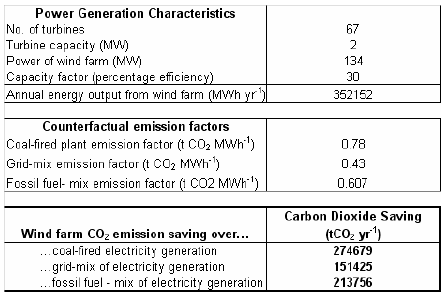
Figure A2.4.1. Worksheet 1. Wind farm CO2 emission saving
A2.5. Loss of carbon due to production, transportation, erection, operation and dismantling of wind farm
Ideally, a full life cycle assessment should be carried out to calculate the carbon emission savings of a wind farm. This may be prohibitively expensive on a site by site basis so generic data could be used instead.
Carbon emissions from the full life cycle of a wind farm include CO 2 emissions that occur during production, transportation, erection, operation, dismantling and removal of turbines, foundations and the transmission grid from the existing electricity grid, E life (t CO 2MW-1). Emissions reported in the peer-reviewed literature have a range of 0.006 (White and Kulcinski, 2000) to 0.034 t CO 2 MWh -1 (White, 2007). Assuming a wind farm lifetime of 25 years and a capacity factor of 30%, this equates to emissions of 394 to 8147 t CO 2MW-1. Very high emissions associated with a high grid mix used in production ( e.g. Japan, 1.237 t CO 2MWh -1 (Lenzen and Munksgaard, 2002) have been excluded from this analysis.
Defensible figures for the specific wind farm should be used wherever possible, but if these are unavailable, carbon dioxide emissions due to the turbine life, L life (t), can be estimated from the turbine capacity, c turb ( MW), using the following equation. This equation was derived using data from 18 European sites with a highly significant fit (P>0.95).
![]()
Evaluation against independent data indicates that using this equation instead of site specific measurements will introduce an average error in estimated carbon dioxide emissions of 39%. However, the uncertainty in estimated carbon payback time introduced by this error is small and decreases with turbine capacity: uncertainty is less than 6 months for a turbine capacity under 0.5 MW; less than 1.5 months for a turbine capacity between 0.5 and 1 MW, and approximately 1 month for a turbine capacity over 1 MW. Note that inclusion of a life cycle figure for wind farms would ideally require that equivalent life cycle costs for conventional power sources are included in the carbon emission savings figure. However, in the absence of comparative figures for coal and gas generating plants, it should be noted that this is an over-estimate of the life cycle costs of a wind farm. A comprehensive life cycle assessment of a modern UK wind farm would provide more robust figures.
For the example wind farm, the CO 2 emissions due to production, transportation, erection, operation and dismantling, E life, is given in the environmental statement as 176000 tCO 2 wind farm -1.
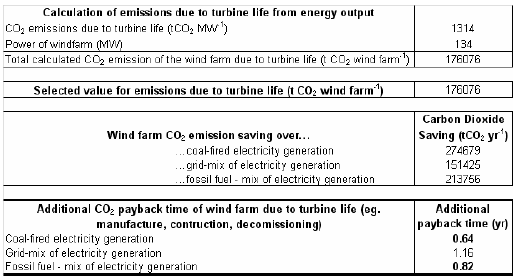
Figure A2.5.1. Worksheet 2. CO 2 loss due to turbine life
A2.6. Loss of carbon due to backup power generation
Because wind generated electricity is inherently variable, accompanying backup power is required to stabilise the supply to the consumer. The extra capacity needed for backup power generation, p back, is currently estimated to be 5% of the rated capacity of the wind plant if wind power contributes more than 20% to the national grid (Dale et al., 2004). Note that this estimate will be revised in a report commissioned by the Scottish Government, which is shortly to be published.
If wind generated electricity contributes less than 20% to the national grid, the extra capacity needed for backup is assumed to be zero (p back = 0%).
The reserve capacity required for backup, c reserve (MWh yr -1), is estimated from the number of turbines in the wind farm, n turb, the turbine capacity, c turb ( MW), and the extra capacity needed for backup power generation, p back (%).

The total loss of carbon emission savings due to backup power generation depends on the type of energy used to provide the backup. Here it is assumed that fossil fuel provides the backup, although the payback time is calculated assuming the different counterfactual cases as before.
The backup power generates energy which is used, so it is not attributable to the wind farm losses. However, additional emissions result from reduced thermal efficiency of the reserve generation, p therm (%). The additional emissions are approximately 10% (p therm = 10%). The total loss of carbon emission savings due to backup power generation, L back (t CO 2), is calculated from the additional emissions, p therm (%), the reserve capacity required for backup, c reserve (MWh yr -1), the backup fuel emission factor, E fuel (t CO 2 MWh -1 - see paragraph 9), and the life time of the wind farm, t (years).
![]()
The Renewable Energy Statistics Database for the UK (2008) states that in 2006, 23% of the electricity generated from renewables was from wind energy, p wind, (offshore and onshore). Taking this as an upper limit, and assuming a linear increase in the contribution of wind power over time, the contribution of wind power to the national grid will not exceed 20% until 2038.

Because the national grid operates over the whole of the UK, it is argued that the UK target should be assumed (p renew,2 = 20% by t 2 = 2020; BERR, 2008) rather than the Scottish Government target. Taking the 2005 (t 1) figure of 8.5% (p renew,1) contribution of renewable energy to the UK national grid, the contribution of wind power to the UK national grid will not exceed 20% until 2107. The case-study wind farm was officially opened in 2006 (t 0), with an estimated lifetime (t) of 25 years. Because the average percentage contribution of onshore wind energy to the national grid is less than 20% over the lifetime of the wind farm, the extra capacity required for backup, c reserve, is assumed to be 0%. This then gives a reserve capacity of 0 MWh yr -1, which gives an additional payback time of 0 years.
If the current contribution to wind generated electricity had been greater than 20%, the extra capacity required for backup, c reserve, would have been assumed to be 5%. This then gives a reserve capacity of 5869 MWh yr -1, which results in an additional payback time for the fossil-fuel mix counterfactual of 0.42 years (5 months).
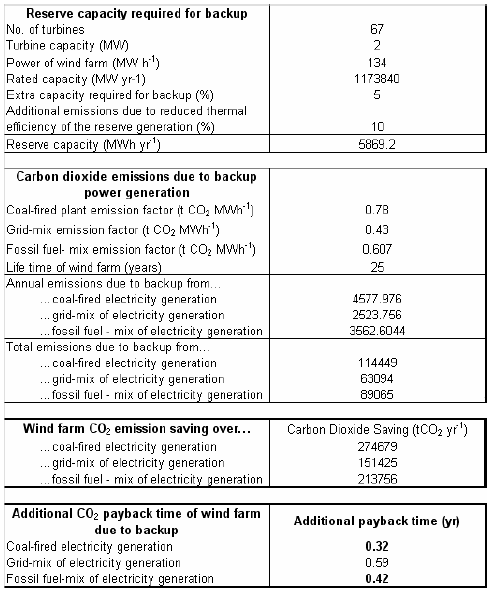
Figure A2.6.1. Worksheet 3. CO 2 loss due to backup
A2.7. Change in carbon dynamics of peat lands
Peat lands (which include mires, fens, bogs and other wetlands associated with peat land) contain huge reservoirs of carbon. Globally, they represent over one-third of the carbon in all soils (Hargreaves et al., 2003). The total amount of carbon held in organic soils in Scotland is 2735 Mt C, with 1778 Mt C being held in peats (including blanket peats, basin peats, and semi-confined peats; Smith et al, 2007). In their undisturbed state, peat lands emit the greenhouse gas methane, but accumulate carbon derived from the atmosphere. Emissions of the greenhouse gas nitrous oxide are usually negligible in unfertilised peat lands ( IPCC, 1997). Overall, peats represent a large reservoir of CO 2 captured by plants and held in soils. The first step in the accumulation of carbon in soil is sequestration from the atmosphere by vegetation through photosynthesis. The second step is storage in soil organic matter. Organic matter accumulates primarily in response to anaerobic, waterlogged conditions and low potential for decomposition either through temperature or acidity constraints in the soil. Wind farm development on peat lands will result in a change in the carbon dynamics by changing the carbon inputs and altering peat land hydrology, which affects soil organic matter turnover. This note calculates both the direct and indirect impacts of a wind farm development on the carbon dynamics of peat lands. Changes in carbon due to habitat improvement and site restoration are also included to give a holistic measure of the effect of wind farm development on the carbon dynamics of peat land.
A2.8. Loss of carbon fixing potential of peat lands
The development of a wind farm requires the construction of infrastructure such as turbine foundations, crane hard standings, access tracks and works compounds. Generally, peat is removed from these areas and as a result there is a loss of the carbon fixing potential of the associated vegetation. During construction and operation of a wind farm, the soil may be drained by design or unintentionally. Drainage has significant effects on the vegetation of peat lands (Stewart and Lance, 1991). Here, the loss of the carbon fixing potential of the peat land is calculated for the area from which peat is removed and also for the area affected due to drainage.
The estimated global average for the apparent carbon accumulation rate in peat land ranges from 0.12 to 0.31 t C ha -1 yr -1 (Turunen et al., 2001; Botch et al., 1995). If it is available, site specific data can be used. However, this loss represents a very small proportion of the total emissions, so the mid-range value used in the previous guidance (0.25 t C ha -1 yr -1 = 0.92 t CO 2 ha -1 yr -1) provides an adequate estimate. Loss of carbon fixing potential of peat land, L fix (t CO 2), is calculated from the area affected by wind farm development (both directly by removal of peat, A direct (ha - see paragraph 34), and indirectly by drainage A indirect (ha - see paragraph 44)), the annual gains due to the carbon fixing potential of the peat land, G bog (G bog = 0.92 t CO 2 ha -1 yr -1), and the time required for habitat restoration, t restore (years).
![]()
In the example wind farm, carbon fixation by bogs is assumed to be 0.25 t C ha -1 yr -1 (0.92 t CO 2 ha -1 yr -1), the total area where fixation by plants is lost is calculated to be 180 ha, and the time required for regeneration of the peat land habitat is assumed to be the lifetime of the wind farm (25 years). This results in a negligible loss of carbon fixation by plants, equivalent to an additional carbon dioxide payback time assuming the fossil-fuel-mix counterfactual of less than 0.02 years.
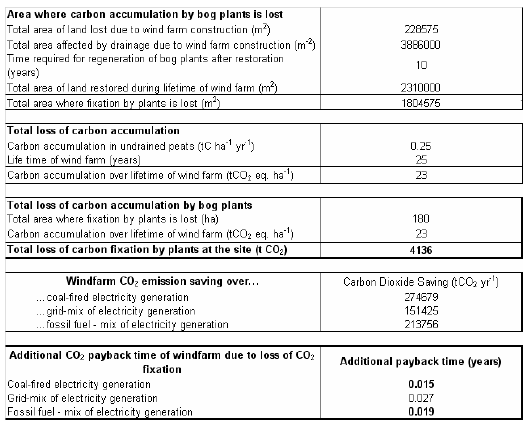
Figure A2.8.1. Worksheet 4. Loss of CO 2 fixing pot.
A2.9. Changes in carbon stored in peat lands
Note: this carbon represents the greatest risk in terms of potential loss of carbon dioxide because peat takes a long time to accumulate in temperate regions and hence site restoration and carbon savings need to reflect this.
During wind farm construction, carbon is lost directly from the excavated peat and indirectly from the area affected by drainage.
The potential impact of peat removal is estimated from the volume of peat removed by different practices. Loss of carbon from the excavated peat is assumed to be 100%. If the excavated carbon is later restored, so potentially reducing the carbon losses from excavated peat, this is added to the area and depth of the improved site. This allows good peat preservation practices to be accounted for in the C emission savings.
Indirect loss of carbon due to drainage is estimated using default values from the Intergovernmental Panel on Climate Change ( IPCC) ( IPCC, 1997) as well as by more site specific equations derived from the scientific literature (Smith et al., 2007, Nayak et al., 2008).
Carbon gains due to habitat improvement are similarly estimated using IPCC default values ( IPCC, 1997) and the more site specific equations derived from the scientific literature (Smith et al., 2007, Nayak et al., 2008).
A2.9.1. Loss of carbon from removed peat
The total volume of peat removed during construction, V direct (m 3), is calculated from the dimensions of structures introduced to the site during development (average length, l i (m), width, w i (m), and depth, d peat,i (m) of each construction, i). Borrow pits, turbine foundations, hard-standing area and access tracks are currently included in the spreadsheet.
![]()
The total area of peat removed, A direct (m 2), is calculated similarly using average length and width.
Loss of carbon from the removed peat, L direct (t CO 2), is assumed to be 100%. If peat is later returned to the site with full restoration of the habitat and hydrological conditions, the volume of restored peat is added to the calculation of C emission savings due to site improvement. However, for this option to be used, the restoration plan should demonstrate a high probability that peat hydrology will be restored and disturbance of peat minimised.
Loss of carbon from the removed peat, L removed (t CO 2), is calculated from the carbon content of dry peat, pC drypeat (%), the dry soil bulk density (dried to a constant weight at 105° C), BD drysoil (g cm -3), and the volume of peat removed, V direct (m 3).

When flooded, peat soils emit less carbon dioxide but more methane than when drained. In flooded soils, carbon dioxide emissions are usually exceeded by plant fixation, so the net exchange of carbon dioxide with the atmosphere is negative and soil carbon stocks increase. When soils are aerated, carbon dioxide emissions usually exceed plant fixation, so the net exchange of carbon dioxide with the atmosphere is positive. To calculate the carbon emissions attributable to removal of the peat only, L direct (t CO 2 eq.), any emissions occurring if the soil had remained in situ and undrained are subtracted from the emissions occurring after removal.
![]()
Calculation of the losses from undrained soil is described in paragraph 51.
For the example calculation, the soil moisture content is assumed to be 90% (the moisture content of peat ranges from 90% to 93% - MLURI et al., 1991). The carbon content of dry peat, pC drypeat, is assumed to be 55% (the carbon content of dry peat ranges from 49 to 62% ( MLURI et al., 1991). The fresh bulk density, BD freshsoil, is specified as 1.00 g cm -3. This gives an additional payback time for the fossil-fuel-mix counterfactual of 0.21 years. The carbon emissions due to removed peat are low due to the avoidance of excavated roads, so reducing the volume of peat removed. Better site specific estimates could be obtained using actual measurements at the site.
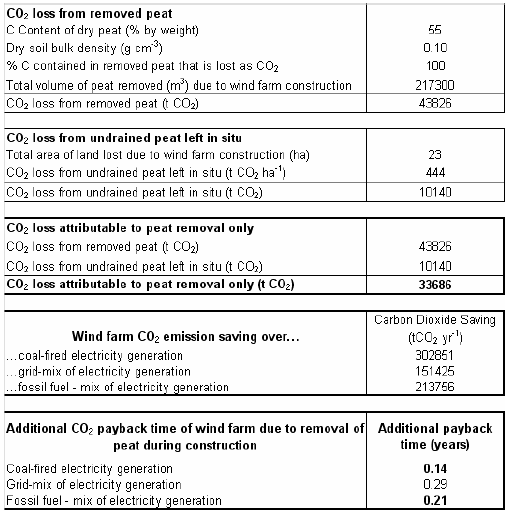
Figure A2.9.1. Worksheet 5b. CO 2 loss from removed peat
A2.9.2. Loss of carbon from drained peat
Estimation of volume of peat affected by drainage
The extent of drainage around the site of construction strongly influences the total volume of peat impacted by the construction of the wind farm. Where sufficient measurements are available to describe the hydrological features of the wind farm area, this should be used together with a detailed hydrological model to simulate the likely changes in peat hydrology. If insufficient measurements are available, a worst case estimate of extent of drainage around the development features should be used.
The volume of peat affected by drainage is calculated assuming the additional drained zone of e drain (m) on each side of the construction. Note that the area where peat is removed should not be included because carbon loss from removed peat has already been counted in direct losses. The calculation of volume affected by drainage, V indirect,i (m 3), uses the extent of drainage, e drain (m), average length, l i (m), width, w i (m), and depth of drainage, d drain,i (m) for each construction feature, i.
For borrow pits, and turbine and hard-standing foundations, the depth of drainage, d drain,i (m), is assumed to be equivalent to the depth of the construction. The calculation uses the following equation.
![]()
(equation for turbine & hard-standing foundations)
The volume drained around switching stations, site compounds and lay-down areas can be calculated similarly. If permanent drainage around foundations and hard-standing is not required, the area should be assumed to be drained only up to the time of completion of backfilling, removal of any temporary surface drains, and full restoration of the hydrology. The carbon losses are then reduced from the restored area as discussed in paragraphs 48 to 61.
For access tracks, the depth of any drainage and the area included is dependent on the type of track. For excavated and rock-filled roads, the depth of drainage, d drain,i (m), is assumed to be equivalent to the depth of the track. The peat removed or displaced by construction of the track is not included in the drained volume. The volume affected by drainage is calculated using the following equation.
![]()
(equation for cable trenches, excavated and rock-filled roads)
The volume affected by drainage around cable trenches with permeable linings ( e.g. sand) that deviate from the lines of tracks should also be calculated using the above equation.
For floating roads, drainage is only included for the length of track that has been specifically drained, and the depth of drains is taken to be as specified for the drains. Since floating roads are known to sink in many cases, evidence should be provided about the risk of requirements for additional drainage. The volume affected by drainage is calculated using the following equation.
![]()
(equation for floating roads)
The total volume of peat affected by drainage, V indirect (m 3), is the sum of the volumes of peat affected around each type of construction, V i,indirect (m 3).
![]()
The total area of peat affected by drainage, A indirect (m 2), is calculated similarly from the length and width of constructions and the estimated extent of drainage.
In the given example, the extent of the impact of drainage is assumed to be the worst case of 100m around each drainage feature. This gives a total area affected by drainage, A indirect, of 389 ha, containing a total volume of peat affected by drainage, V indirect (m 3), of 7772000 m 3.
Loss of carbon from drained peat if the site is not restored after decommissioning
When flooded soils are drained, loss of soil carbon continues until a new stable state is reached. For peats, this is close to 0% carbon ( IPCC, 1997). Therefore, if the site is not restored after decommissioning of the wind farm, it is assumed that 100% of the carbon will be lost from the drained volume of soil. The loss of carbon dioxide from a drained peat where the site is not restored is calculated according to the method given in paragraph 37. The loss of carbon from the drained peat, L drained (t CO 2), is calculated from the carbon content of dry peat, pC dry peat (%), the dry soil bulk density (dried to a constant weight at 105° C), BD dry soil (g cm -3), and the volume of peat drained, V indirect (m 3).

In the example calculation, it is assumed that the habitat management plan for the site includes full restoration of the hydrology and habitat following decommissioning. Therefore, loss of soil carbon is calculated as described in the next section. However, if the site had not been restored the additional CO 2 payback time due to the effects of drainage using the fossil-fuel-mix counterfactual would be 5.12 years. These additional emissions of carbon are relatively low at the case-study site, due to good practice in the use of floating roads to minimise the need for additional drainage.
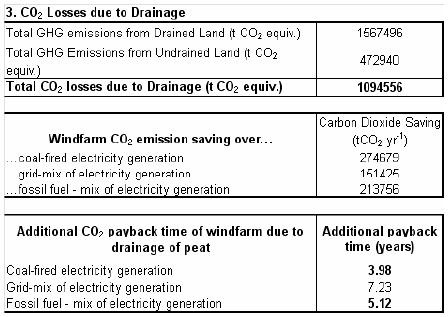
Figure A2.9.2. Worksheet 5d. CO 2 loss from drained peat (site not reinstated)
Loss of carbon from drained peat if the site is restored after decommissioning
Restoration of the site could potentially halt carbon loss processes, allowing carbon dioxide emissions to be limited to the time before the habitat and hydrological conditions are restored. The amount of carbon lost is then calculated from the annual emissions of methane, E CH4 (t CO 2 eq. ha -1 yr -1), and carbon dioxide, E CO2 (t CO 2 ha -1 yr -1), the area of drained peat, A indirect (ha), and the time until the site is restored, t (years). However, for this option to be used, the restoration plan should demonstrate a high probability that peat hydrology will be restored across the site (water table at the surface for over 50% of the year), disturbance of the remaining peat will be minimised, and peat forming vegetation will develop in areas from which peat was removed or drained. If restoration of the site is inadequate, the amount of carbon lost will be in between the range of values calculated for restored and non-restored sites (paragraph 46).
Methane emissions are calculated using the following equation:

where E CH4 is the total annual emissions of CH 4 (t CO 2 eq. ha -1 yr -1), R CH4 is the annual rate of CH 4 emissions (t CH 4-C ha -1 yr -1), D F is the number of days in the year that the land is flooded, and C CH4-C? CO2 converts CH 4-C to CO 2 equivalents (C CH4-C? CO2 = 30.67 CO 2 eq. (CH 4-C) -1). The emission factors used (R CH4, and D F) differ between drained and undrained conditions as described in paragraphs 54 to 59.
Carbon dioxide emissions are calculated using the following equation:

where E CO2 is the total annual emissions of CO 2 (t CO 2 ha -1 yr -1), R CO2 is the annual rate of carbon dioxide emission (t CO 2 ha -1 yr -1), D F is the number of days in the year that the land is flooded. The emission factors used (R CO2, and D F) differ between drained and undrained conditions as described in paragraphs 54 to 59.
The total loss of carbon from the peat before drainage, L undrained (t CO 2 eq.), is calculated from the annual emissions of methane, E CH4 (t CO 2 eq. ha -1 yr -1), the annual emissions of carbon dioxide, E CO2 (t CO 2 ha -1 yr -1), the area to be drained, A indirect (ha), and the time to restoration (assumed to be the life time of the wind farm), t (years).
![]()
The total loss of carbon from the drained peat, L drained (t CO 2 eq.), is calculated, using the same equation, but calculating the annual emissions of carbon dioxide, E CO2 (t CO 2 ha -1 yr -1) and methane, E CH4 (t CO 2 eq. ha -1 yr -1) for a drained soil. Methane emissions will be negative or close to zero due to oxidation of methane by the soil.
![]()
Peat soils emit less carbon dioxide but more methane when flooded than drained. In flooded soils, carbon dioxide emissions are usually exceeded by plant fixation, so the net exchange of carbon dioxide with the atmosphere is negative and soil carbon stocks increase. In drained soils, carbon dioxide emissions usually exceed plant fixation, so the net exchange of carbon dioxide with the atmosphere is positive. To calculate the carbon emissions attributable to drainage only, L indirect (t CO 2 eq.), any emissions occurring if the soil had remained undrained are subtracted from the emissions occurring after drainage.
![]()
The annual emissions of methane and carbon dioxide can be estimated either using the IPCC default methodology ( IPCC, 1997), or using more site specific equations derived from the scientific literature (Nayak et al., 2008).
Calculation of changes in methane and carbon dioxide emissions from drained peat based on IPCC Guidelines
The IPCC default factors for acid bogs and fens in cool temperate zones used in paragraphs 49 and 50 are given in Table A2.9.1. When the soil is undrained, the period of flooding is based on the monthly mean temperature and the length of inundation. When the soil is drained, the period of flooding is assumed to be zero (D F = 0 days yr -1).
| Acid Bogs |
Fens |
|
|---|---|---|
| Number of days in the year that land is flooded, D F |
178 |
169 |
| Annual rate of CO 2 emissions from drained soils, R CO2 (t CO 2 ha -1 yr -1) |
35.2 |
35.2 |
| Annual rate of CH 4 emissions from flooded soils, R CH4 (t CH 4-C ha -1 yr -1) |
4.015 x 10 -2 |
0.219 |
Table A2.9.1. IPCC default emission factors used to calculate
methane and carbon dioxide emissions
These are widely accepted, generic emission factors, but the figures are averaged across cool temperate peat lands and allow no use of site specific information, such as water table depth before wind farm development. Under the impacts of climate change, or if the site is not an peat land, the water table depth may already have been lowered before any drainage associated with the development. In this case, it is recommended that the more site specific factors given below are used as described in the next section.
Calculation of changes in methane and carbon dioxide emissions from drained peat using site specific equations
Methane emissions are calculated using the site specific equation described by Nayak et al. (2008), as shown below.

where R CH4 is the annual rate of methane emissions (t CH 4-C (ha) -1 yr -1), T is the average annual air temperature (° C), pH is the soil pH and d water is the water table depth (m). This equation was derived from 40 experiments on acid bogs and fens, and has an associated R 2 value of 52.7%, P <0.0001. By statistical convention, if P<0.01 this relationship can be considered to be highly significant.
Carbon dioxide emissions are calculated using the site specific equation described by Nayak et al. (2008), as shown below.

where R CO2 is the annual rate of carbon dioxide emissions (t CO 2 (ha) -1 yr -1), T is the average annual air temperature (° C), d peat is the peat depth (m) and d water is the water table depth (m). This equation was derived from 41 experiments on acid bogs and fens, and has an associated R 2 value of 53.8%, P <0.0001. By statistical convention, if P<0.01 this relationship can be considered to be highly significant.
The experimental data used to derive the above equations were collated during the development and evaluation of the ECOSSE model (Smith et al., 2007). Note that further improvement in a site specific estimate of methane, carbon dioxide and dissolved organic carbon losses could be obtained using measurements taken at the site to run a peer-reviewed and proven model of carbon dynamics, such as ECOSSE.
These more site specific annual emission rates are used in the equations given in paragraphs 49 and 50, assuming days of flooding, D F, given in table 2 to estimate annual emissions of carbon dioxide and methane.
For the case-study, carbon dioxide payback time is very small due to good practice in the use of floating roads to minimise the need for additional drainage. The payback time is reduced from 5.12 years (no restoration) to 2.20 years calculated using the IPCC default values, and 1.87 years using the site specific emission factors.
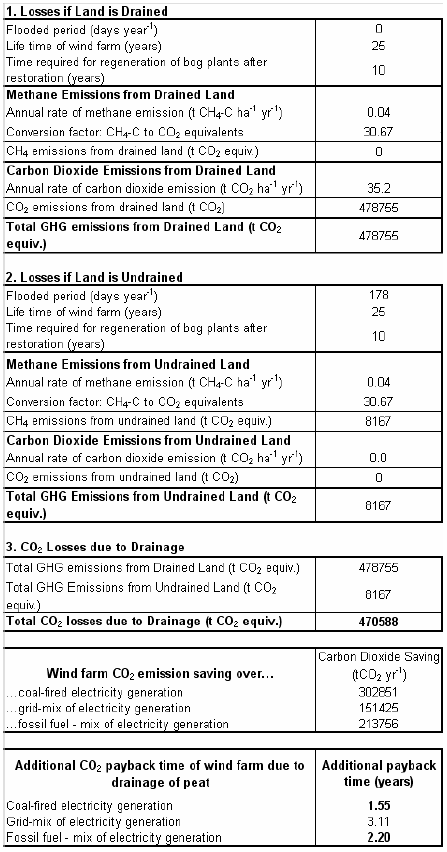
Figure A2.9.3a. Worksheet 5d. CO 2 loss from drained peat (site restored - emission factors IPCC, 1997)
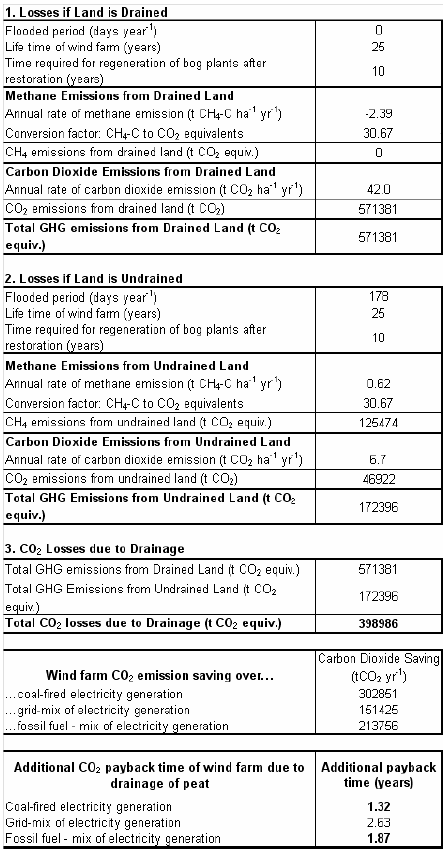
Figure A2.9.3b. Worksheet 5d. CO 2 loss from drained peat (site restored - emission factors Nayak et al., 2008)
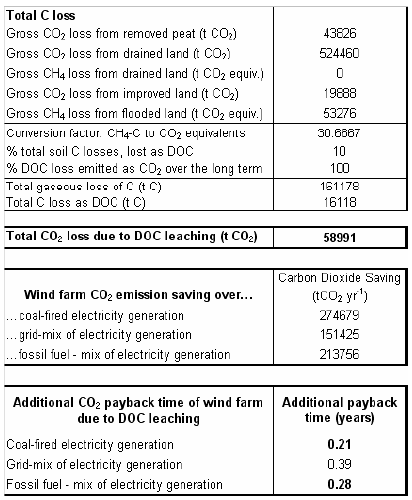
Figure 2.9.4. Worksheet 6. CO 2 loss due to leaching of DOC and POC
A2.9.3. Loss of carbon dioxide due to leaching of dissolved and particulate organic carbon
Lowering the water table by drainage may reduce the potential for dissolved and particulate organic carbon retention within the soil ( e.g. Holden et al., 2004; Worrall et al., 2004) as well as increasing the decomposition rates (due to increased aeration). A recent study by Wallage et al. (2006) confirms that losses of dissolved organic carbon are higher from drained than undrained peats. Losses of carbon dioxide due to leaching of dissolved organic carbon, LDOC (t CO2), are calculated by multiplying the sum of the gaseous losses of carbon from the different sources in the soil, Lgas (t C), by the percentage of the total gaseous loss of carbon that is leached as dissolved organic carbon, pDOC (%), and the percentage of leached dissolved organic carbon that is emitted as carbon dioxide, pDOC? CO2 (%).

Losses due to leaching of dissolved organic carbon are assumed to be less than 10% of total gaseous carbon loss from the drained, restored and improved habitat peat land (p DOC = 10) following the work of Dillon and Molot (1997) and Worrall et al. (2003). It is assumed that 100% of the dissolved organic carbon is emitted as carbon dioxide (p DOC? CO2 = 100). Losses of particulate organic matter are calculated similarly, assuming the percentage loss is less than 15% of the total gaseous carbon losses after Worrall et al. (2003).
In the example, total gaseous emissions of carbon were small, resulting in low losses of dissolved organic carbon. This was due to the large proportion of the site that was improved.
A2.9.4. Loss of carbon due to peatslide
The Scottish Executive (2006) has established a rigorous procedure for identifying existing, potential and construction induced peat landslide hazards. This should lead to reduced likelihood of peat landslides occurring. Any drainage measures used to mitigate the risk should be accounted for using the methods described in paragraphs 39 to 64. It is assumed that required measures to avoid peat landslides have been taken, so that the risk of peat landslide is minimal. Therefore this potential source of carbon loss is omitted from the guidance. Note that less catastrophic erosion losses, such as due to collapse of gullies, is not covered by the procedures to reduce peat landslides, but has not yet been included in this guidance.
A2.10. Loss/saving of carbon due to forestry clearance
The presence of extensive areas of forestry on and in the vicinity of the wind farm site can significantly reduce the yield of wind energy, so it may be necessary to clear existing forestry. The losses of carbon from tree biomass depend on the fate of wood products following felling. Forestry may be felled earlier than planned due to the wind farm development, so limiting the nature and longevity of wood products. If a forestry plantation was due to be felled with no plan to replant, the effect of the land use change is not attributable to the wind farm development and should be omitted from the calculation. If, however, the forestry is felled for the development, changes in timber, residues and changes in soil conditions are attributable to the wind farm and should be accounted for.
The amount of carbon loss from timber and residues depends on the type of tree, the age of crop on felling, the end use of the timber and how quickly any stored carbon is returned to the atmosphere (Cannell, 1999). Cannell (1999) provides estimates for the amounts of carbon sequestered by fast growing trees (~26 yr rotation - e.g. poplar), medium (ï¾ 55 yr rotation - e.g. Sitka spruce), and slow growth (ï¾ 92 yr rotation, e.g. beech).
| Poplar |
Sitka |
Beech |
|
|---|---|---|---|
| Yield Class (m 3 ha -1 yr -1) |
12 |
16 |
6 |
| Carbon sequestered, G forest (t CO 2 ha -1 yr -1) |
26.8 |
13.2 |
8.8 |
| Crop rotation, t forest (years) |
26 |
55 |
92 |
| CO 2 sequestered per crop rotation (t CO 2 ha -1) |
694.66 |
724.68 |
808.86 |
Table A2.10.1. Carbon sequestration for different species of tree
Loss of carbon dioxide due to forestry clearance, L forest (t CO 2) is obtained from the area of forestry to be felled, A forest (ha), the average carbon sequestered per year, G forest (t CO 2 ha -1 yr -1) and the lifetime of the wind farm, t (years).
Lforest = Aforestx Gforest x t
In the case-study, 480 ha Sitka Spruce is felled. This large area of forestry felling results in an additional carbon dioxide payback time of 0.52 to 1.05 years. If the felling of all or part of the forestry is not attributable to the wind farm development, this area should not be included in the calculation of carbon loss.
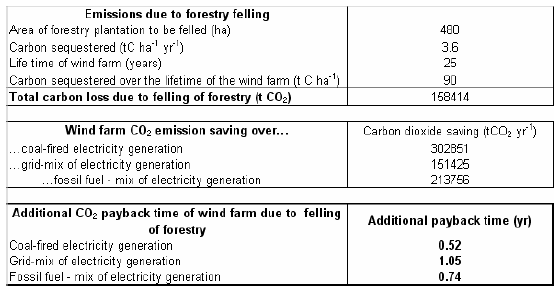
Figure A2.10.1. Worksheet 7. CO2 loss - forestry clearance
European forest soils contain approximately the same amount of carbon as is found in tree biomass (Smith et al., 2006). Managed arable and grassland soils store significantly less carbon than soils under forestry or semi-natural management (Smith et al., 2005; Smith et al., 2006). The change in soil carbon stocks on tree removal will depend on subsequent land management, especially the drainage regime. These are calculated as described in paragraphs 39 to 64.
A2.11. Carbon dioxide saving due to improvement of peat land habitat
Habitat improvement at disturbed sites can significantly impact carbon emissions, potentially preventing further losses and increasing carbon stored in the improved habitat. Carbon gains due to habitat improvement are estimated using IPCC default values ( IPCC, 1997) and site specific equations derived from the scientific literature (paragraphs 41 to 50). Emissions of nitrous oxide are assumed to be negligible in unfertilised peat lands ( IPCC, 1997). However, for this option to be used, the improvement plan should demonstrate a high probability that peat hydrology will be restored and disturbance of peat minimised, resulting in rapid decolonisation of the natural vegetation.
To calculate the carbon emissions attributable to improvement only, L improvement (t CO 2 eq.), any emissions occurring if the soil had remained drained are subtracted from the emissions occurring after flooding (negative, indicates a net reduction in emissions).
![]()
The reduction in total greenhouse gas emissions are given below for the example wind farm using the IPCC default methodology and the site specific equations. Using fossil-fuel-mix as the counterfactual, the reduction in payback time amounts to 1.01 years using the IPCC methodology, and 1.78 years using the site specific approach.
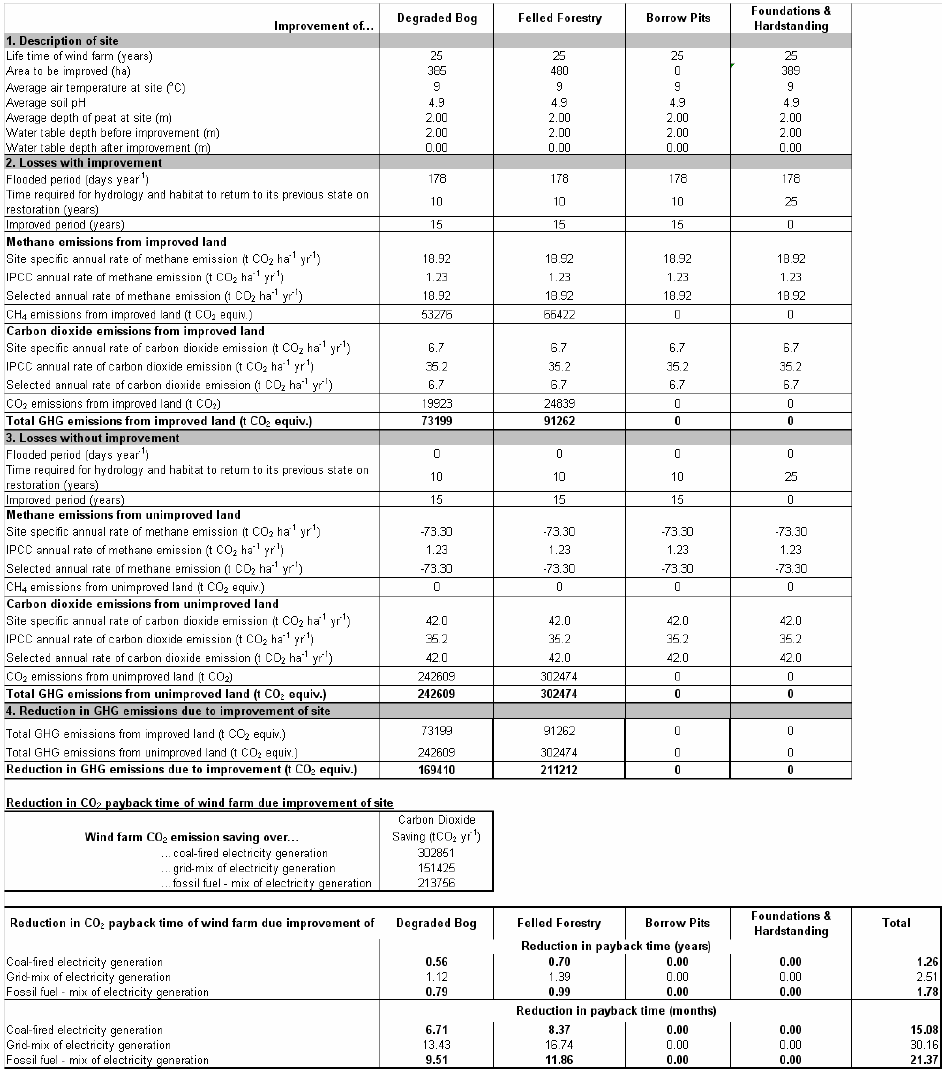
Figure 2.11.1. Worksheet 8. CO 2 gain due to restoration. Emission factors from Nayak et al. (2008)
A2.12. Calculation of payback time for the example case-study wind farm
The carbon payback time for a wind farm is calculated by comparing the net loss of carbon from the site due to wind farm development, L tot (t CO 2 eq.), with the carbon savings achieved by the wind farm while displacing electricity generated from coal fired capacity, grid mix or fossil fuel mix.
![]()
where L life is the total loss of C emission savings due to production, transportation, erection, operation and dismantling of the wind farm (t CO 2 - see paragraph 19), L back is the total loss of carbon emission savings due to backup power generation (t CO 2 - see paragraph 25), L fix is the loss of carbon fixing potential of peat land (t CO 2 - see paragraph 29), L direct is the loss of carbon from the removed peat (t CO 2 - see paragraph 37), L indirect is the loss of carbon due drainage (t CO 2 eq. - see paragraph 53), L DOC is the loss of carbon dioxide due to leaching of dissolved organic carbon (t CO 2 - see paragraph 62), L forest is the loss of carbon dioxide due to forestry clearance (t CO 2 - see paragraph 68), L improvement is the loss (negative = gain) of carbon emissions due to habitat improvement (t CO 2 eq. - see paragraph 72).
The calculation of total carbon dioxide emission savings and payback time for the example wind farm are shown below. Note the very short payback time, due to good practice in the use of floating roads and the large area of habitat improvement.
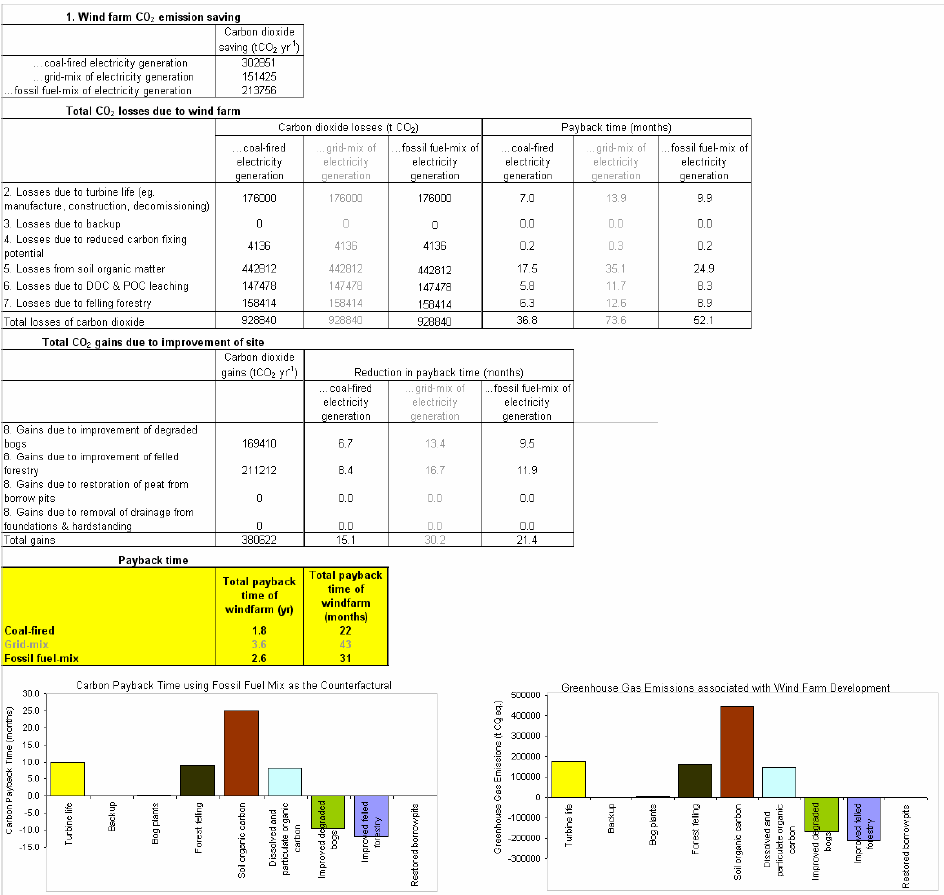
Figure 2.12.1. Worksheet. Payback time
A2.13. Input sheet for the example case-study wind farm

Figure 2.13.1. Worksheet. Input data
A2.14. References
Baggott, S.L., Cardenas, L., Garnett, E., Jackson, J., Mobbs, D.C., Murrells, T., Passant, N., Thomson, A. and Watterson, J.D. (2007). UK Greenhouse Gas Inventory, 1990 to 2005. Annual Report for submission under the Framework Convention on Climate Change. London, HSO. ISBN 0-9554823-1-3. http://www.naei.org.uk/reports.php. Report AEAT/ENV/R/2429 13/04/2007
BERR (2008). UK Renewable Energy Strategy.
http://www.berr.gov.uk/energy/sources/renewables/strategy/page43356.html
Botch, M.S., Kobak, K.I., Vinson, T.S. and Kolchugina, T.P. (1995). Carbon pools andaccumulation in peat lands of the Former Soviet Union. Global Biogeochemical Cycles, 9, 37-46.
Bradley, R.I., Milne, R. , Bell J., Lilly, A., Jordan, C. and Higgins, A. (2005). A soil carbon and land use database for the United Kingdom. Soil Use and Management, 21, 363-369
Cannell, MGR (1999) Growing trees to sequester carbon in the UK: answers to some common
Questions. Forestry, 72, 238-247.
Carbon Trust/Dti (2004), Renewables Network Impacts Study. http://www.carbontrust.co.uk/Publications/publicationdetail.htm?productid=CT-2004-03
Dale, L, Millborrow, D, Slark, R and Strbac, G (2004) Total Cost Estimates for Large-Scale Wind Scenarios in UK, Energy Policy, 32, 1949-56.
Defra (2001) Climate Change Agreements: Guidance on converting electricity from dedicated supplies to primary energy. CCA 09, December 2001
Department for Business Enterprise & Regulatory Reform (2007). Digest of United Kingdom Energy Statistics http://stats.berr.gov.uk/energystats/dukes07.pdf
Department of Trade and Industry ( DTI) (2006). Energy Trends, March 2006.
Department of Environment, Food and Rural Affairs (Defra) (2007). Guidelines to Defra's GHG conversion factors for company reporting (Defra, June 2007)
Digest of the United Kingdom Energy Statistics (2007). Department for Business, Enterprise and Regulatory Reform. A National Statistics Publication, London, HSO. ISBN 9780115155208. http://www.berr.gov.uk/energy/statistics/source/electricity/page18527.html
Dillon, P.J. and Molot, L.A. (1997) Effect of landscape form on export of dissolved organic carbon, iron, and phosphorus from forested stream catchments. Water Resources Research, 33, 2591-2600.
Hargreaves, K.J., Milne, R. and Cannell, M.G.R. (2003). Carbon balance of afforested peat land in Scotland. Forestry ,76, 299-317.
Holden, J., Chapman, P.J., Labadz, J.C. (2004). Artificial drainage of peat lands: hydrological and hydrochemical process and wetland restoration. Progress in Physical Geography, 28, 95-123.
International Panel on Climate Change, IPCC (1997). Revised 1996 IPCC guidelines for national greenhouse gas inventories workbook, vol. 2. Cambridge, UK. Cambridge University Press.
Key Scottish Environment Statistics (2007). http://www.scotland.gov.uk/Publications/2007/08/20165714/0
Lenzen, M. and Munksgaard, J. (2002). Energy and CO2 life-cycle analysesof wind turbines Review and applications. Renew. Energy, 26, 339-362.
MLURI et al., (1991) xxx
Nayak, D.R., Miller, D., Nolan, A., Smith, P. and Smith, J.U. (2008). Calculating Carbon Savings from Windfarms on Scottish Peat lands - Revision of Guidelines. October 2007 to January 2008. Final Report. RERAD UAB-016-07.
Renewable Energy Statistics Database for the UK (2008).http://www.restats.org.uk/obligations.htm
Scottish Executive (2006) http://www.scotland.gov.uk/Publications/2006/12/21162303/1
Scottish Government (2008) http://www.scotland.gov.uk/Topics/Business-Industry/Energy/19185/17612
Scottish Natural Heritage (2007). Annual Review 2006/07. Scottish Natural Heritage, Battleby. pp 36.
Smith, J.U., Smith, P., Wattenbach, M., Zaehle, S., Hiederer, R., Jones, R.J.A., Montanarella, L., Rounsevell, M.D.A., Reginster, I. and Ewert, F. (2005). Projected changes in mineral soil carbon of European croplands and grasslands, 1990-2080. Global Change Biology, 11, 2141-2152.
Smith, P., Smith, J.U., Wattenbach, M., Meyer, J., Lindner, M., Zaehle, S., Hiederer, R., Jones, R., Montanarella, L., Rounsevell, M., Reginster, I. and Kankaanpää, S. (2006). Projected changes in mineral soil carbon of European forests, 1990-2100. Canadian Journal of Soil Science, 86, 159-169.
Smith, P., Smith, J.U., Flynn, H., Killham, K., Rangel-Castro, I., Foereid, B., Aitkenhead, M., Chapman, S., Towers, W., Bell, J., Lumsdon, D., Milne, R., Thomson, A., Simmons, I., Skiba, U., Reynolds, B., Evans, C., Frogbrook, Z., Bradley, I., Whitmore, A. and Falloon, P. (2007). ECOSSE: Estimating Carbon in Organic Soils - Sequestration and Emissions. Final Report. SEERAD Report. ISBN 978 0 7559 1498 2. 166pp.
Stewart, A.J.A. and Lance, A.N. (1991). Effects of moor-draining on the hydrology and vegetation on northern Pennine blanket bog. Journal of Applied Ecology, 28(3), 1105-1117.
The Carbon Trust, (2007). http://www.carbontrust.co.uk/resource/measuring_co2/ Measuring_CO2_Examples.htm
Turunen, J., Pitkänen, A., Tahvanainen, T. and Tolonen, K. (2001). Carbon accumulation in West Siberian mires, Russia. Global Biogeochemical Cycles, 15, 285-296.
Wallage ZE, Holden J and McDonald AT. (2006). Drain blocking: An effective treatment for reducing dissolved organic carbon loss and water discolouration in a drained peat land. Science of the Total Environment, 367, 811-821.
White, S.W. and Kulcinski, G.L. (2000). Birth to death analysis of the energy payback ratio and CO 2 gas emission rates from coal, fission, wind, and DT fusion electrical power plants. Fusion Engineering Design, 48, 473-481.
White, W.S. (2007). Net energy payback and CO 2 emissions from three Midwestern wind farms: an update. Natural Resources Research. 15, 271 - 281.
Worrall, F., Reed, M., Warburton, J., Burt, T. (2003). Carbon budget for a British upland peat catchment. The Science of the Total Environment, 312, 133-146.
Worrall, F., Harriman, R., Evans, C.D., Watts, C., Adamson, J., Neal, C., Tipping, E., Burt, T.P., Grieve, I., Montieth, D., Naden, P.S., Nisbet, T., Reynolds, B. and Stevens, P. (2004). Trends in dissolved organic carbon in UK rivers and lakes. Biogeochemistry, 70, 369-402.
Contact
Email: Econsents@gov.scot
There is a problem
Thanks for your feedback